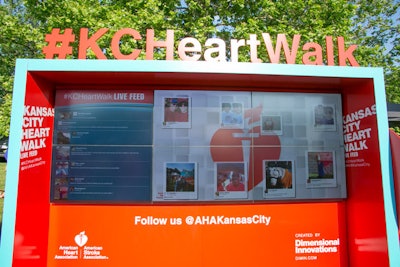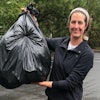
The American Heart Association hosts more than 300 Heart Walk events annually in cities around the country, and the events are a critical part of the association’s fund-raising strategy. Now the organization is exploring how to better integrate social media to boost interest and engagement before, during, and after the events. A pilot program kicked off this summer in three cities—in Kansas City, Minneapolis, and New York—and organizers say they are now looking to expand the effort.
"The event itself is the fund-raising aspect, but now it’s how can we make the run-up to an event more interesting, how can we keep people engaged, how can we keep them connected and excited year-round,” says David Woody, the association’s business technology strategist.
The association worked with Tint, a company that produces branded social hubs that can pull content from 10 networks (Facebook, Instagram, Twitter, Google Plus, Vine, and others) to display on large screens or websites. At the Minneapolis event at Target Field, organizers displayed the stream on the Jumbotron and 50 smaller screens throughout the venue. In Kansas City, a local architectural firm designed a free-standing structure, about the size of a bus shelter, to house the display monitors. “We know at events this is a great time to get people into our social media realm," says Ciara O’Brien Murray, communications director in the association’s Kansas City metro office. "This was a way to bring people in better than just a small poster with the hashtag. We put this big presence in the middle of this park that was aesthetically pleasing and drew them in.”
The display showed a live feed of posts with the #KCHeartwalk hashtag on the left third and then a curated feed of images on the rest of the screen. Murray says planners were surprised to find the display became a popular backdrop for selfies, as people would wait for their photos to appear and then snap a picture of themselves in front of it. The hashtag trended in Kansas City for nine hours, and those posts reached more than 260,000 people while the walk took place. The local chapter also amassed 70 new Twitter followers and 40 new Facebook likes during the event.
The Kansas City walk raised more than $850,000, and Murray says she believes that number can grow if the organization integrates social media more directly into the fund-raising. One option is a new feature from Tint to incorporate a “donate now” button into the display, so those viewing it on a website could click a link to contribute to the cause. Murray said they may also ask sponsors and partner companies to create a day-of-giving campaign in the weeks prior to the event. Each company would have a unique hashtag and Tint feed that could be displayed within the workplace to generate interest, and then all of the Tint feeds could be incorporated into the large display the day of the walk.
At the national level, organizers say one goal is to better incorporate social media strategy into the long-term event plans; the idea for this pilot program developed just three weeks before the walks. “We have to get way out in front of the event cycle and start working the staff such that they’re thinking of innovations and ways to market it, so it’s not just something added on to the side,” Woody says. He also wants to tailor the strategy to match the capabilities and needs of individual walk locations, for example identifying venues with existing displays or determining the most effective way to leverage social media before the walks based on the unique characteristics of each community.



















